Bananas are a favorite fruit in our home because they are so very inexpensive, even the organic bananas are much cheaper per pound than other fruits. And when I can find them marked down because they’re getting brown I buy all I can. We love to dehydrate bananas to make banana chips and banana jerky.
Dried bananas are a fantastic healthy snack that doesn’t have any added sugar. When you make homemade banana chips you can be sure they don’t have any of the questionable ingredients that store bought banana chips have. There are several different methods for dehydrating bananas and when properly stored, dried bananas are shelf stable for a year or more.

The best bananas for dehydrating are those that are at peak ripeness, this means firm with just a few brown spots. The most important thing is that they are still fairly firm.
Overripe bananas tend to be mushy, so use those for making banana bread muffins. Or freeze overripe bananas to use later.
So, if you have extra bananas at the end of the week, be sure to dehydrate them into chew dried banana chips.
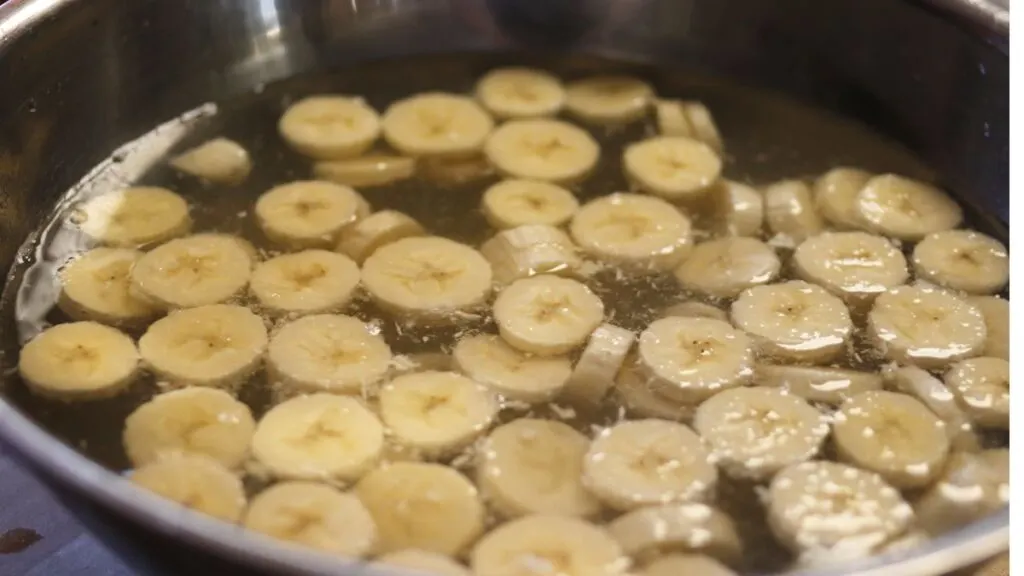
Pre-treating Bananas
Like apples, bananas can turn dark when exposed to air. To slow down this process, bananas can be pre-treated, just dip banana slices water and an acid. You can use 1/2 cup lemon juice in 1/2 gallon water or 3 finely crushed 500-mg vitamin C tablets in a 1/2 gallon of water. If you prefer to buy a commercial product there are a couple, Ball Fruit Fresh and Mrs. Wages Fresh Fruit Preserver, which are a mixture of ascorbic acid and citric acid which is the most effective mixture for preventing fresh fruits from browning.
Just know that lemon juice and vitamin C tablets are a lot cheaper.
You can also use any high acid fruit juice, such as pineapple juice. Just be aware that it will change the flavor a bit.
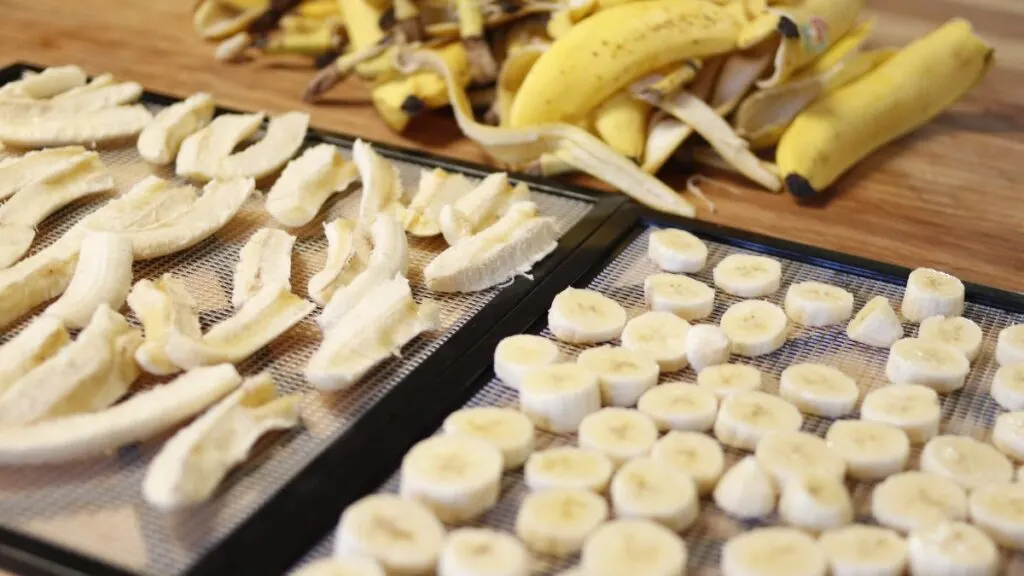
How to make banana jerky
Banana jerky is just dehydrated banana sticks. Most of my kids prefer banana sticks to banana chips, I think because they’re chewier. I’m not a fan of either, but everyone else in my family (and my kids’ friends) love them.
To make dehydrated banana strips, peel the bananas and break them in half. We collect the banana peels to compost by burying them around various plants (trench composting.)
Divide each half into thirds. Bananas naturally have three sections so we just gently push our finger down the center lengthwise and the banana divides.
Pretreat the banana pieces if you don’t want them to turn brown (we don’t care so I usually skip this step.)
Lay the banana sticks on the dehydrator racks in a single layer. Put them in the dehydrator until dried. In our dehydrator (at 135°F) it takes about a day to dehydrate bananas. Just check them every so often to get them to the texture you like. We like them when they’re still a bit flexible and not crispy or hard.
The drying time will vary depending on how much moisture is in the bananas, how humid your climate is and the temperature of your dehydrator.
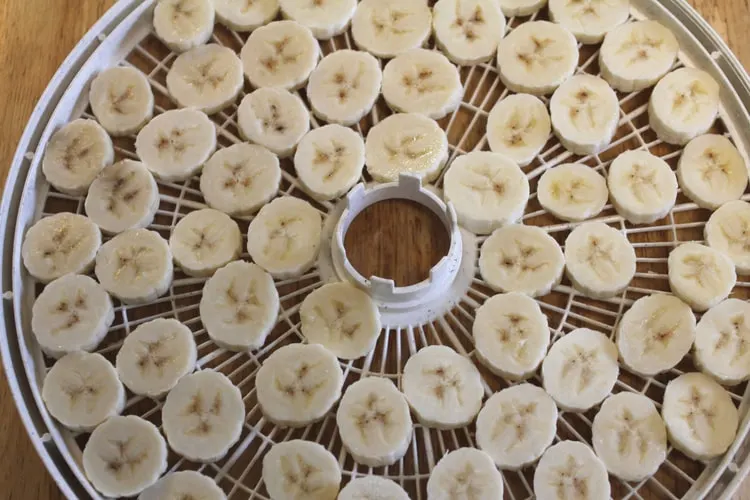
How to make chewy dehydrated banana chips
Are you looking to make crispy banana chips at home, you know like the ones you find at the store? Well, it’s probably not going to happen. If you just love the crispiness of store bought dried chips, enjoy them occasionally but don’t expect your home dehydrated banana chips to have the same texture of banana chips from the store. Store bought banana chips are usually fried which gives them that crispness.
Even though homemade banana chips are different than store bought I think you’ll enjoy them just as much once you accept that they’re different.
To make dehydrated banana chips, peel the bananas and slice them into 1/4-inch slices. Collect the banana peels to compost.
Pretreat the sliced bananas, if you don’t want them to turn brown (we don’t care so I usually skip this step.)
Lay the banana chips on a dehydrator tray in a single layer. Put them in the dehydrator until dried. In our dehydrator (at 135°F) it takes about 8 hours to dehydrate bananas chips. Just check them every so often to get them to the texture you like.
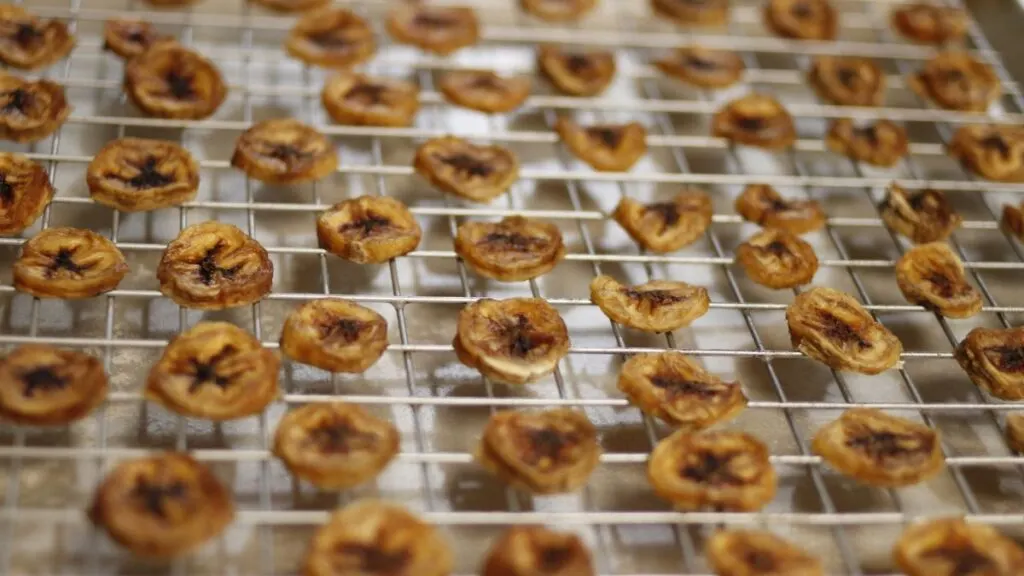
Oven instructions for dried banana chips
If you don’t have a dehydrator, using the oven is a good way to dry bananas. The process is pretty much the same as using a dehydrator, however, I would only do banana chips and not banana strips in the oven because of how long it takes to dehydrate them. Even as banana chips, they will take all day to dehydrate in the oven.
Prepare a baking sheet by putting a wire rack on it. You can also put parchment paper on the baking sheet to make clean-up a little easier. You can also brush the wire rack with a bit of oil to prevent the banana chips from sticking to the wire rack.
Peel and thinly slice bananas (1/4-inch slices).
Pretreat the banana slices, if desired.
Lay the banana slices out on the wire rack in a single layer. You can brush coconut oil on the banana slices for crunchy banana chips (they still won’t be as crunchy as store bought.)
Put the baking tray and rack with the banana slices on it in the oven on the lowest temperature possible. Ideally, this will be pretty close to 135F which is the temperature for dehydrating fruit. If you’re oven doesn’t go down that low, you can use a wooden spoon to keep the oven door ajar to reduce the heat a bit.
While this is a good option if you don’t have a dehydrator, my family doesn’t care for dried banana chips made in the oven. They just don’t seem to get crispy enough.
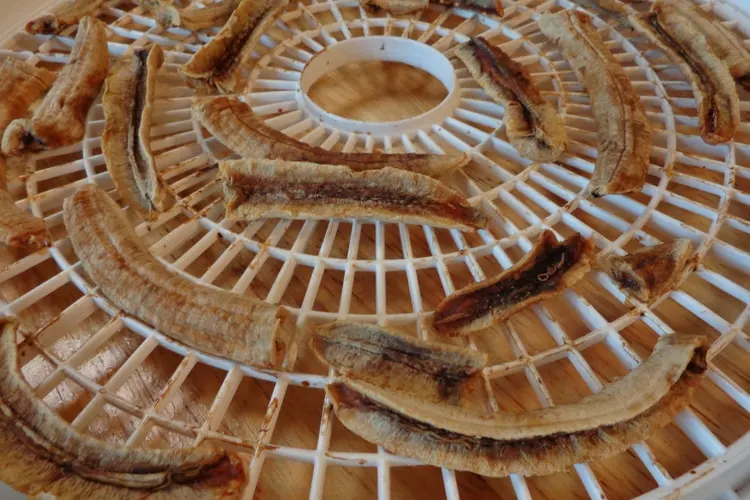
Storing dehydrated bananas
Once the bananas are done dehydrating, let them cool to room temperature, and then put them in an airtight container. Before storing, dried bananas, like all dehydrated fruit, needs to be conditioned.
Before putting them away, the dried bananas need to be conditioned, just like other dehydrated fruit.
After drying or pasteurizing, conditioning of dried foods is the last step before final storage.
For fruit, place the cooled product in a tightly sealed glass jar, shaking daily for 7–10 days. If condensation develops (inside of the jar), return to the dehydrator for more drying. Package dried food for long-term storage after conditioning for 10 days. Remember to keep food with high vitamin A or C out of direct sunlight during storage.
Ohio State University Extension
Fully dehydrated banana chips should store well for several months in an air-tight container. For long term storage, I store them in wide mouth quart size mason jars and use my food saver attachment to remove the air and seal the jar. Packaged this way, the shelf life is easily a year or more. If you don’t have a vacuum sealer, you can use an oxygen absorber.
Label jars and store in a cool, dark place.
How to use dried bananas
Dried bananas are a perfect snack all by themselves. But they can also be added to granola or trail mixes, used as toppings for cereal, oatmeal or yogurt. We also like to use the dried banana sticks to dip in peanut butter. Or they can be reconstituted.
Another way to dehydrate bananas is to make it into fruit leather and then dehydrate it.
How to reconstitute dehydrated bananas
Reconstituted dried bananas can be used like fresh bananas – obviously, they won’t be exactly like fresh bananas but they’re pretty close. To reconstitute dehydrated bananas put one part bananas to one part water in a sauce pan and simmer for 5 minutes.
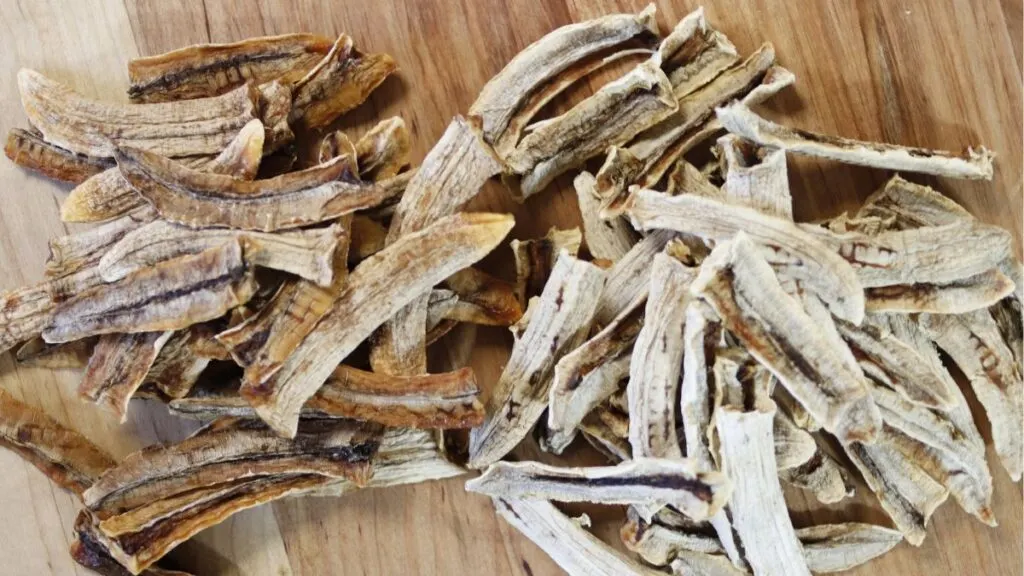
Choosing a food dehydrator
Over the years I’ve used several different dehydrators and all of them have worked great. I prefer one that has an adjustable temperature gauge, but if you have one that doesn’t have a temperature gauge, it will still work just fine.
I have a Presto dehydrator that is inexpensive but doesn’t have a temperature control, so I tend to use is less than my other dehydrators. This one takes up the least space for storage, which is nice.
I have a Nesco dehydrator that I found at a garage sale for $5 that works great and does have a temperature control. If I’m doing a lot of trays, I end up having to move them around a bit to get even airflow.
When I was writing my first book, The Ultimate Guide to Preserving Vegetables, I bought the most basic Excalibur so I could see what all the hype was about. I do love the Excalibur dehydrator, but it’s expensive and it takes up more space (but not much more than the Nesco). One thing that I love about it, is that you can use it for things that require certain temperatures, like proofing bread and making yogurt. The other ones can’t be used for things like that since the trays stack.
Tried this recipe? Please leave a ⭐️⭐️⭐️⭐️⭐️ star rating in the recipe card below and/or a review in the comment section further down the page. We always appreciate your feedback. You can also save the recipe for later by pinning it or clicking on the heart in the lower right hand corner.
Chewy Dried Banana Chips
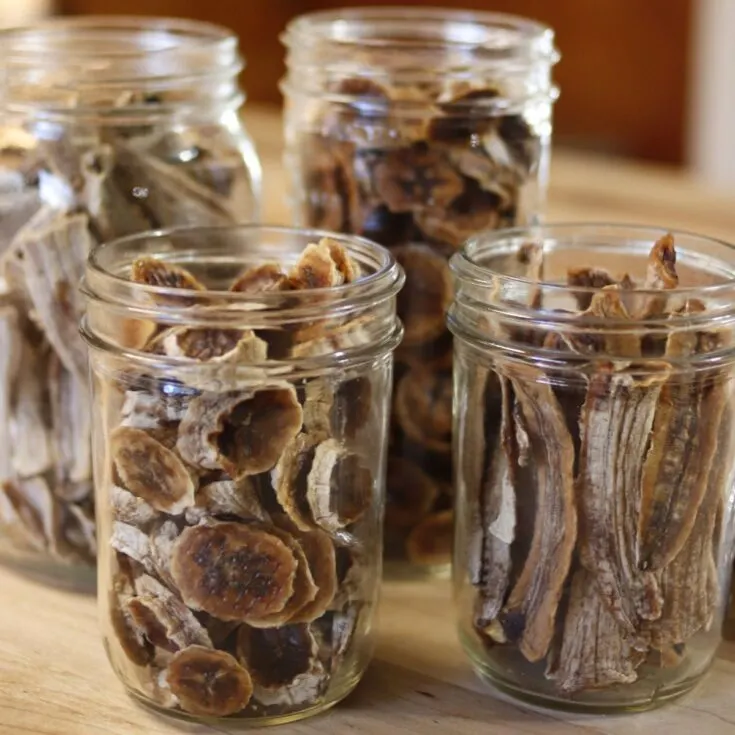
Chewy banana chips make a great snack! Use this recipe to make banana chips in the dehydrator or oven.
Ingredients
- 6 pounds bananas
- 1/2 cup lemon juice (or other acid for pretreatment)
- 1/2 gallon water
Instructions
- Peel the bananas
- If making banana chips, slice bananas in 1/4" slices. If making banana jerky, break the bananas in half then divide each half of banana into thirds.
- Dip banana slices (or sticks) in a lemon juice mixture or citric acid and water if you don't want them to turn brown. You can also put the the liquid in a spray bottle and spray them which works great if you're dehydrating a lot of bananas.
- Lay the banana pieces in a a single layer on the dehydrator trays
- Put them in the dehydrator until dried. In our dehydrator (at 135°F) it takes 8-12 hours to dehydrate bananas. Just check them every so often to get them to the texture you like. We like them when they're still a bit flexible and not crispy or hard.
- Put dried bananas in labeled airtight containers and condition them for 7-10 days.
- Store bananas in cool, dry place
Notes
This recipe can be scaled up or down depending on how many bananas you have.
The recommended ratio of lemon juice to water is 1:1 according the National Center for Home Food Preservation. In the older Ball Blue Book the recommended ratio is 4:1 - four cups water to one cup lemon juice. You can use as much or as little lemon juice as you want, or none at all, since this isn't a safety recommendation.
Recommended Products
As an Amazon Associate and member of other affiliate programs, I earn from qualifying purchases.
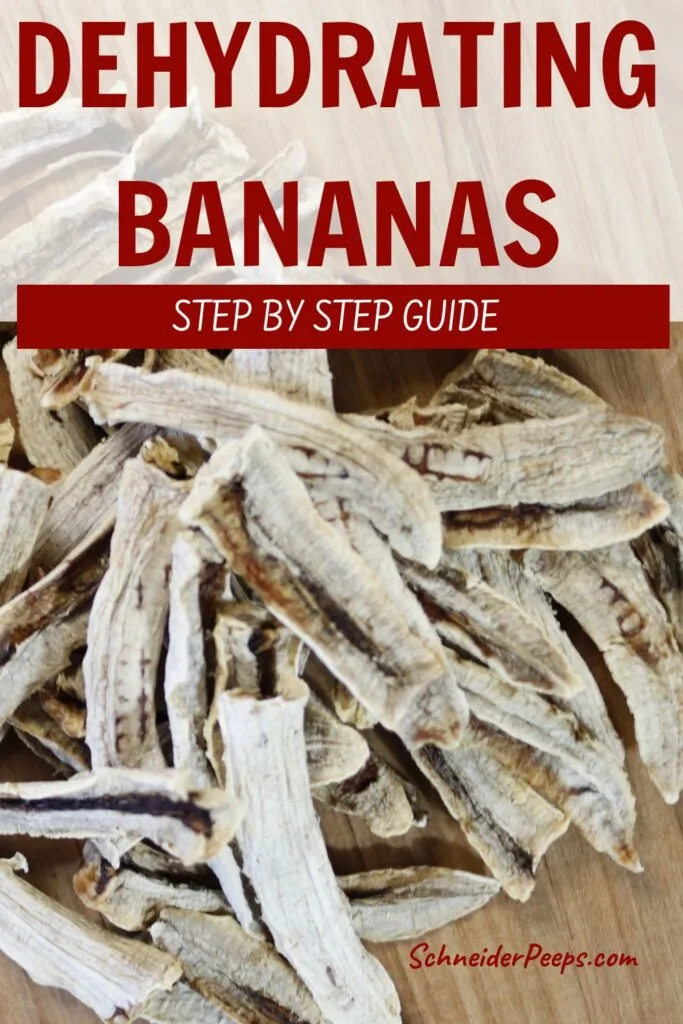

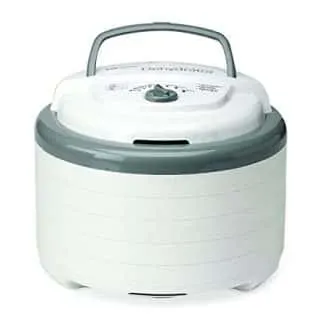
Brenda s Johnson
Monday 25th of October 2021
I have the done bananas a couple of times and I haven't sprayed the crate or the parchment paper and they stick what am I doing wrong
Angi Schneider
Monday 25th of October 2021
Hmmm, I'm sure... these will not be as dry as store bought banana chips. Mine stick to the dehydrator trays some but not terribly bad. If the bananas are super ripe, they will be more sticky because they have more sugar content.
Corrine Moser
Tuesday 10th of November 2020
HELP!!! My banana chips are firm and not sticky when I put them in a (lidded) jar for conditioning, but hours later they're all stuck together and soft. Is this normal, or am I not dehydrating long enough? I've had this happen with cherries also.
Angi Schneider
Friday 13th of November 2020
If you live in a humid area this is more likely to happen. As long as there is no condensation in the jar they are dry enough. For long term storage I would suggest using silica (desiccant) packets or food saver bags (or using the food saver to seal the lid).
Lorrie Harris
Saturday 31st of October 2020
I have dried bananas for many years. When our Boys were in school they took a brown bag lunch--usually including dried fruit of one kind or another. My method of drying bananas was to push my finget down the center of the banana lengthwise, not dip them in any citric acid and dry them. The finished prodect was what the Boys gleefully called "Dried Benena Sl;ugs". You can imagine the fun they had taking "Dried Banana Slugs" to school for lunch!!!
Angi Schneider
Monday 9th of November 2020
What a fun memory! I'll have to share that phrase with my grandson, he'll love it!
Dale Uranis
Saturday 1st of August 2020
In the Ball blue book , it calls for 1 cup of lemon juice to 1 quart of water
Angi Schneider
Sunday 2nd of August 2020
There are quite a few different lemon juice recommendations for the lemon and water mixture. The National Center for Home Food Preservation recommends a 1:1 mixture. You can use whichever one you prefer - or none. We do so many at a time that I skip the lemon juice step.
Ronald Wheeler
Saturday 4th of April 2020
Has anyone ever tried doing different fruits or veggies jerky soaked in beef jerky mix or anything other than beef? Hope this don't sound stupid.
Jeffrey
Monday 11th of May 2020
Having a vegetarian wife, I use my jerky mix to make her jerky using vegetable protein meat (I use farmland protein starters, because it works just like hamburger meat with my jerky gun). I only found a few things I have had to modify, so I can use the base mix for both my meat and her protein stuff is finding vegetarian things in the recipe that are not normal, such as worcestershire sauce. By accident, I found that one of my favorites, cajun power worcestershire sauce, was in fact vegetarian without even researching it first. I am not sure putting fruits and veggies in meat jerky sauce would taste very good.
Angi Schneider
Saturday 4th of April 2020
Hi Ronald, that doesn't sound stupid at all. I've made savory dehydrated vegetables before, in fact, in my upcoming book The Ultimate Guide to Preserving Vegetables, there are several recipes for savory dehydrated vegetables. You'll need to blanch the vegetable first and then soak it in the savory mix before you dehydrate them. My book will be out in early June and it has detailed instructions in it. My best advice is to just try small amounts and keep notes on what you try.